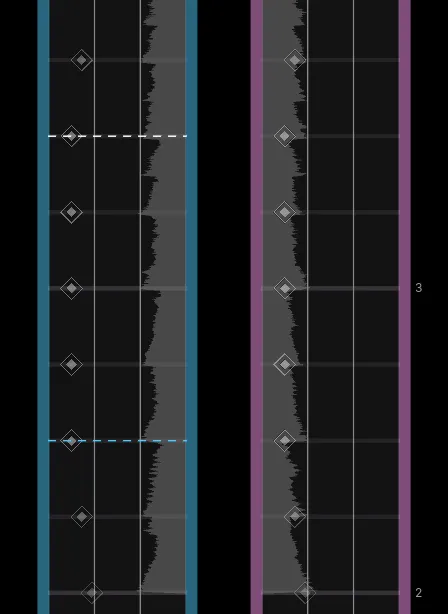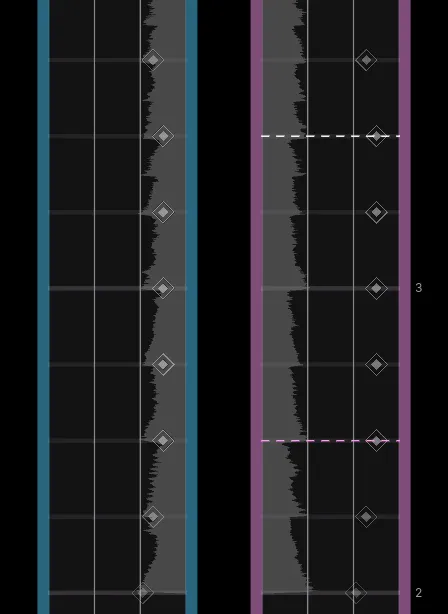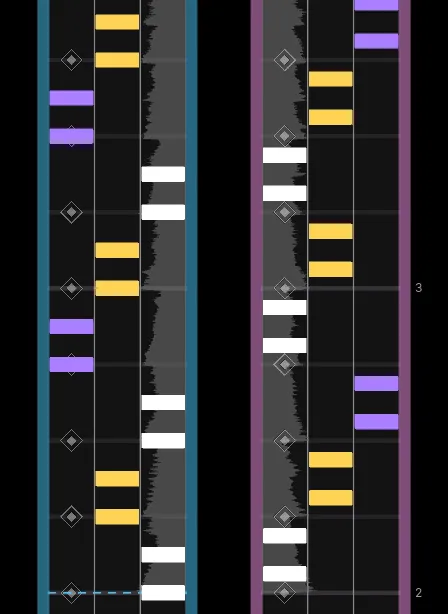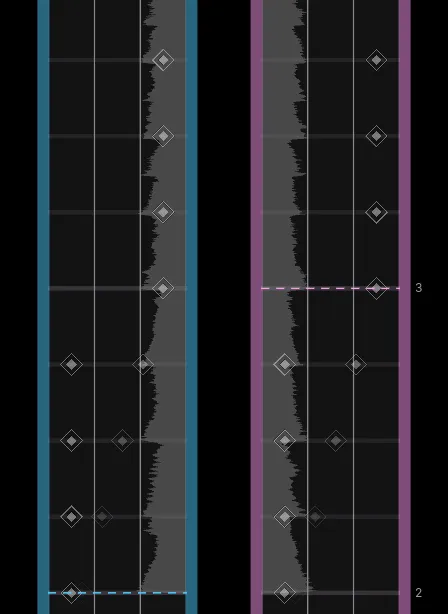Using Drifts
Drifts are another unique note type that charters can use. Of all note types in EX-XDRiVER, drifts are unquestionably the most unique. Drifts are functionally untimed, as they do not require you to start an input on a certain beat. Rather, they require you to perform the drift, via gyroscope and manual input, for the full duration of the note. This is because the drift input takes some time / motion to reach its full, activated state.
Additionally, drifts do not contribute their own combo. Rather, drifts increase the amount of score and EX given by notes within the duration of the drift. Notes on the start beat of the drift are included and give bonus score and EX, while notes on the end beat of the drift are not included. Technically, players can release a drift early or start a drift late if there are no notes at the start / end of the drift. Players can also momentarily stop drifting in the middle of a drift if there is some gap in notes. Drifts in sections with no notes will contribute zero score or EX and therefore do not need to be hit by the player.
Many new charters, including those with experience charting for other games, have a hard time incorporating drifts into their charts. For newer charters, drifts can be simplified into several basic use cases and rules. Charters who adhere to these rules can incorporate drifts in a way that is fun, functional, and representative of the music.
 |  |
|---|---|
| Left Drift | Right Drift |
When To Use Drifts
Section titled “When To Use Drifts”One of the best qualities of drifts is that their indication (a series of small diamonds on 4th subdivisions) is equally good at representing long, sustained sounds and repetitive, sequential sounds. Here are just a few common use cases for drifts:
- There is an effect in the song that is changing over a long period of time (e.g. highpass / lowpass filter, bitcrush, reverb, etc)
- There is a riser playing for a good amount of beats
- There is a sustained background instrument that is playing one note or a series of related notes
- There is a background instrument playing a series of short, sequential notes
- There is a breakbeat, hat loop, or other percussion loop in the song
- There is a section of the song with unique / powerful atmosphere
- There is a sustained synth that is being charted in the main melody that could be emphasized further
Drift Properties
Section titled “Drift Properties”In addition to there being many instances where drifts are less than optimal, drifts must be implemented carefully in order for the chart to work properly in-game.
Drifts and Crowdedness
Section titled “Drifts and Crowdedness”Drifts can add a lot of crowdedness to a section. If you already have a lot of notes in a section, a drift might be too much for the player to read, especially at lower difficulties. If you want to emphasize a unique-sounding part of a song, but don’t want to use a drift to avoid crowdedness, you can alternatively use a simple mod, such as an upwards camera movement with a long duration.

Drift Tails
Section titled “Drift Tails”In XDRV, all drifts need to have a tail. Not using a drift tail will result in issues when the chart is run in-game. Furthermore, drifts with tails have clearer notation for the required inputs, can be hit more consistently by both playstyles, and are less visually stilted when the camera moves or cluttered due to the overlap of symbols.
These drifts are malformed!

Positive and Negative Drift Space
Section titled “Positive and Negative Drift Space”Consider the duration that drifts occupy as positive drift space and the duration that drifts do not occupy as negative drift space. For the majority of charts, the total negative drift space should be greater than the total positive drift space. In other words, the chart should have more beats of non-drifting than beats of drifting. Too much positive drift space in a non-drift-oriented chart may indicate that drifts are used too much (potentially poorly). With that said, a chart can have majority positive drift space if drifts are a central gimmick of the chart.
Additionally, the duration of positive and negative drift space is important. Typically, positive drift space should last 4 beats or longer, as short drifts feel and look strange. Between drifts of alternating directions, you should leave a minimum of 2 beats of space, though more is typically better. Between drifts of the same direction, much more space should be given (upwards of 8-16 beats) to mitigate awkwardness. These values are minimums, not hard rules; you may need to allot more beats of negative space if your chart is at a higher BPM. If you find yourself in a situation where you need to give the player less beats of space, you may need to rework how drifts are used in your chart.
Drifts in Lower Difficulties
Section titled “Drifts in Lower Difficulties”In lower difficulties (BG and NM), whenever a drift is used, the density of notes and gears should be decreased considerably. This is because in lower difficulty charts, drifts are emphasized by the chart when they appear. Of course, some notes are still needed in order to make the drift contribute score and EX.
Ultimately, drifts are a very versatile note type, allowing you to represent background sounds that are more subdued (or in some cases, too fast to be charted accurately). Still, charters should ensure that they adhere to rules that make drifts meaningful, enjoyable, and appropriate.
